Happy Holidays Fellow ChartWatchers!
Here we are, once again, at the final ChartWatchers of the year - of the decade(!) in this case. An awful lot has happened at StockCharts.com this year and I wanted to take a moment and review with you all of the changes and improvements that we've made this year and then tease you a little by hinting at what's to come.
The year kicked off with the publication of a pair of articles about using ChartStyles and StyleButtons to quickly switch between different set of indicators and chart settings.
Next up was the first article in our "Technical Analysis 101" series. Over the course of the year, we published 15 different articles in that series and we still have at least 10 more to go. Look for the next article in that series to appear in January.
February brought a huge change as we added 8 new blogs to our website - including the "ChartWatchers" blog that you are reading now. Since our first blog post on January 30th, we've published over 500 different, free articles in our blogs over the course of 2009. That's more content than we've published over the last 5 years combined!
February also brought news of John Murphy's latest book, "The Visual Investor 2nd Edition." The book was an instant success with lots of new information and updated, easy-to-read charts.
On February 4th we added Site Reliability Reports from the independent testing company Pingdom.com to our website. Now everyone could see - using the "Uptime Report" link on our Support Page - just how reliable our web service is (or is not). It's all there in cold, hard numbers.
On February 23rd our new Status Blog duly noted our first minor site issue since the blog began. The Status Blog has proven invaluable over the course of the year and remains the first place to go if you suspect our site is having trouble.
Finally, on February 28th, we learned that we had won Stocks and Commodities magazine's Readers' Choice Award for Best Technical website for the 8th straight year!
In March, we upgraded the "What's New" area so that it automatically shows you all of the latest blog articles and updates. The "What's New" area appears in the middle of our homepage and on the "Members" page for subscribers.
March was also when we began rolling out the redesign of the website (a process that is still ongoing). We started by updating the look and feel of the Market Message area. As I promised in my blog, the new cleaner look has gradually spread across the entire site.
April saw us celebrating our 10 year anniversary with a huge special and a celebratory logo change. I got nostalgic about it on my blog too.
April also saw us add a second datafeed to our website. The IDC/Comstock feed provided much needed backup and support for our ailing Thomson/Reuters datafeed. In addition, the good folks at IDC continue to be extremely supportive of our use of their data. (Look for us to make a major announcement about new kinds of data from our IDC feed in January.)
Not to be outdone by the datafeed news, our Customer Support team upped their game with the move to our new Customer Support helpdesk area. New FAQs, new articles, new ways to get support were all rolled out and have been a big success. Several new people were also hired to help with customer support.
Finally in April (a very busy month for us!), we announced that Arthur Hill had officially joined the staff as our Senior Technical Analyst. Since then Arthur has written over 300 articles for both our free users and our Market Message subscribers. He has also posted a new blog and countless videos for subscribers so they can follow along as he looks at the charts.
May brought with it a big boost to our Internet connection's capacity as we started the move to a Fiber Gigabit connection. The move had immediate benefits but, unfortunately, we encountered two major problems with the connection later in the year. At this point however things are running smoothly and we are serving more charts than every before these days.
June saw us introduce the new "Create a Chart" bar with auto-completion (just start typing the name or symbol of a stock and we'll find what you are looking for automatically) - a huge improvement for people trying to find stock symbols.
In July we narrowly dodged a bullet when fire broke out at our ISP's main Seattle offices. While we were only offline briefly in the middle of the night, other website hosted at that location for offline for weeks.
In August, we revamped our display of the Top 10 lists placing them prominently on our Home page and, later, on our Free Charts page.
Winding down the year - in October we added Investing Quotes and Site Usage tips to the bottom of many of our pages. November brought the new site design to PerfCharts, CandleGlance and GalleryView pages as well as the completely redone "Free Charts" page.
November was when we also rolled out our Customer Loyalty program and finally joined Twitter. And in December we added our new Data Update blog to let you know when our databases have been updated.
Phew! That's a lot of work and a lot of improvements to the website. The amazing thing is that this doesn't include all the behind-the-scenes stuff like data updates, symbol adds, customer service responses, hardware updates, etc.
The bottom line here is that 2009 has been a GREAT year to be a StockCharts.com member. I hope you have been able to keep up with all the changes and I wanted to make sure you knew how grateful we are that you use our site. Rest assured that we'll be working just as hard in 2010.
Happy Holidays Everyone!
- Chip
A Friday stock bounce kept major stock indexes stuck in a two-month
trading range. Prices also remain above their 50-day averages which
keeps the intermediate uptrend intact. Prices, however, remain below
long-term resistance barriers near 10,500 in the Dow, 1120 in the
S&P 500, and 2200 in the Nasdaq Composite. Although not shown here,
today's unusually heavy trading is due to quarterly futures and options
expiration as well as some index rebalancing. It has little forecasting
value. A modest pullback in the U.S. Dollar also provided some
short-term relief to stocks and commodities. Gold and oil ETFS (GLD and
USO) bounced off their 50- and 200-day moving averages respectively.
Stocks may also be benefiting from a favorable seasonal pattern. Not
only is December a strong month seasonally, but a late-month bounce
(known as the Santa Claus rally) may still lie ahead. That may not be
enough to push stocks out of their trading range, but should be enough
to prevent them from dropping much. Stock traders appear to be
satisfied with protecting their 60% gains in 2009, and don't appear in
the mood for taking on new risks. That also argues for a trendless
market through yearend. Treasuries bonds and notes lost ground on fears
that long-term rates are headed higher in the new year.
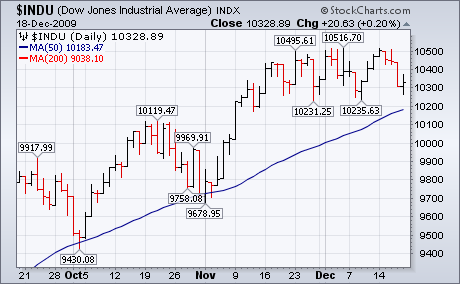
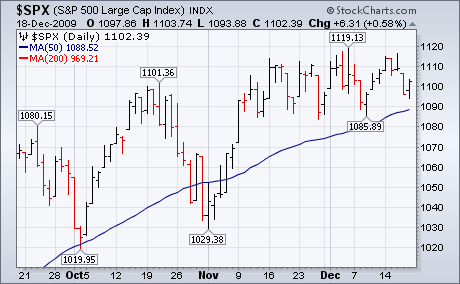

According to the
Stock Traderâs Almanac, the January effect is the historical tendency of small-caps to outperform large-caps from mid December until April. Notice that this period coincides with the bullish six month cycle that extends from November to April. Historically, the strongest period of small-cap outperformance runs from mid December until end January. Judging from small-cap performance in the first half of December 2009, it appears that the January effect is starting early this year. The Perfchart below shows two small-cap indices, the Russell 2000 ($RUT) and Russell Microcap Index ($IJE), and two large-cap indices, the S&P 500 and the S&P 100 ($OEX). From December 1st to December 18th, the two small-cap indices are up, but the two large-cap indices are down. This is some pretty strong outperformance from small-caps.
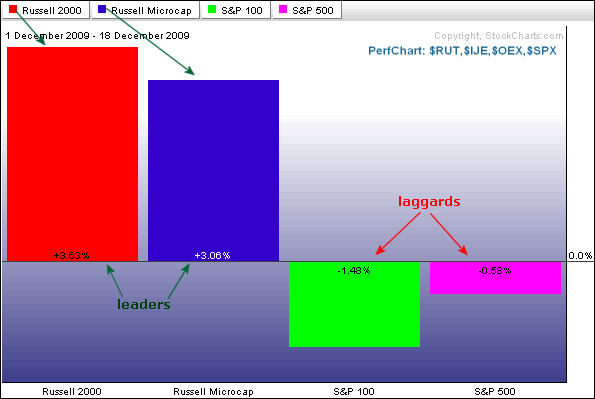
Click image to see a live PerfChart
Since this will be our last article for 2009, I thought it would be
appropriate to do an analysis of the short-, medium-, and long-term
charts and synthesize a broad outlook for the market.
In my December 4 article I said we should expect an upside
breakout, but the market has continued to consolidate in a very narrow
range, still testing the long-term overhead resistance which is drawn
across the declining tops beginning with the 2007 top. In the short
term, we are looking at several weeks of consolidation, which is also
known as a continuation pattern. This means that the most likely
resolution will be an upside breakout that will continue the rally that
began from the November lows.
There is also the issue of the ascending wedge pattern, which
normally breaks to the downside. Should that happen, there is support
at about 1050, on the botom of the slightly rising trend channel.
Because the two prominent short-term set ups are in opposition, I would
have to say that the short-term (days to weeks) picture is neutral.
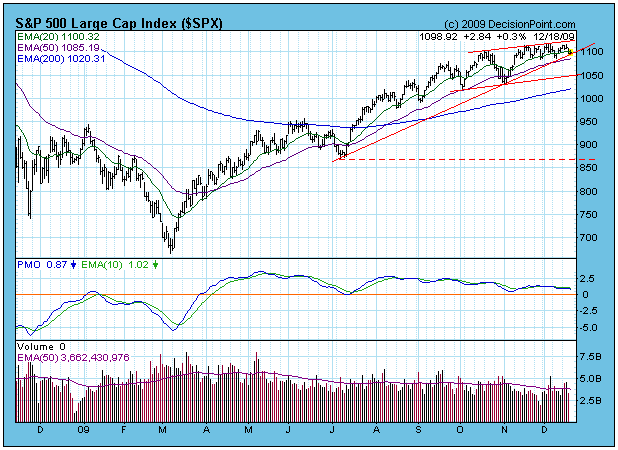
With two opposing possible short-term outcomes, let's look at the
weekly chart, which gives us a medium-term (weeks to months) view of
the market. This chart looks bearish. We can see price stalling at
resistance, and the PMO is overbought and trying to roll over. The
strongest message from this chart is that a medium-term correction is
about to begin.
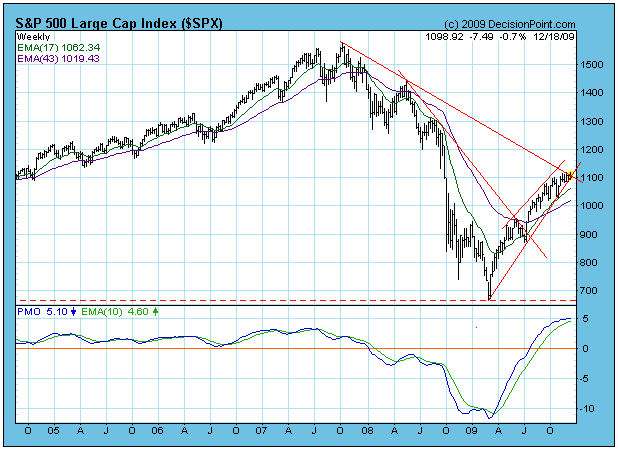
Finally, the monthly chart looks very bullish for the long term (months
to years). I say that primarily because the PMO has turned up from a
deeply oversold reading and has passed up through its 10-EMA. This is
about as bullish a picture as you are likely to see on a monthly chart.
Keep in mind that this doesn't override the medium-term or short-term
picture. If you study the chart carefully, you will see that quite
violent price swings can occur without causing the monthly PMO to
change direction. Nevertheless, the overriding message is that the
long-term direction of the market is most likely to be up.
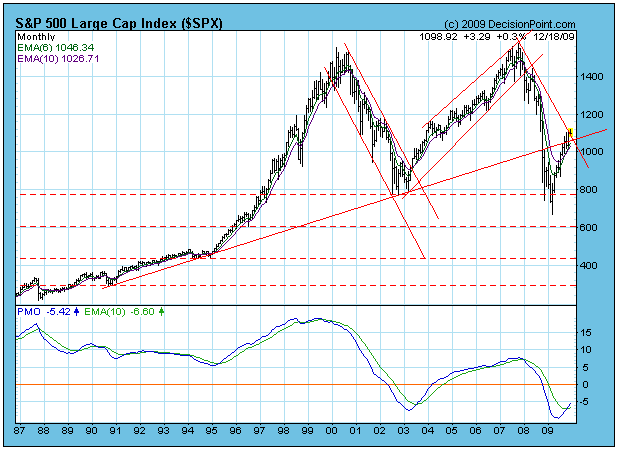
Bottom Line: The short-term chart presents two opposite possible
outcomes, but the medium-term (stronger) time frame points toward a
correction of modest duration; therefore, an upside breakout is
unlikely to be sustained. The long-term (strongest) chart tells us
that, regardless of how severe a correction we experience, the bull
market will ultimately prevail.
In my last article I wrote about the recent disconnect between crude oil and oil services stocks. On a relative basis, oil services stocks had severely underperformed the S&P 500 from mid-October to early December despite crude oil prices trading flat to slightly lower. Since that article, oil prices have begun to climb a bit, but oil services stocks have significantly outperformed the S&P 500, bringing the relationship between the $OSX and crude oil more in line. Other commodities are interesting at this time as well.
After a sharp run up in gold and VERY overbought oscillators, we've seen a significant retracement and we're nearing key short-term price support. I expect gold to hold at this price support level. Take a look at the chart on gold below:
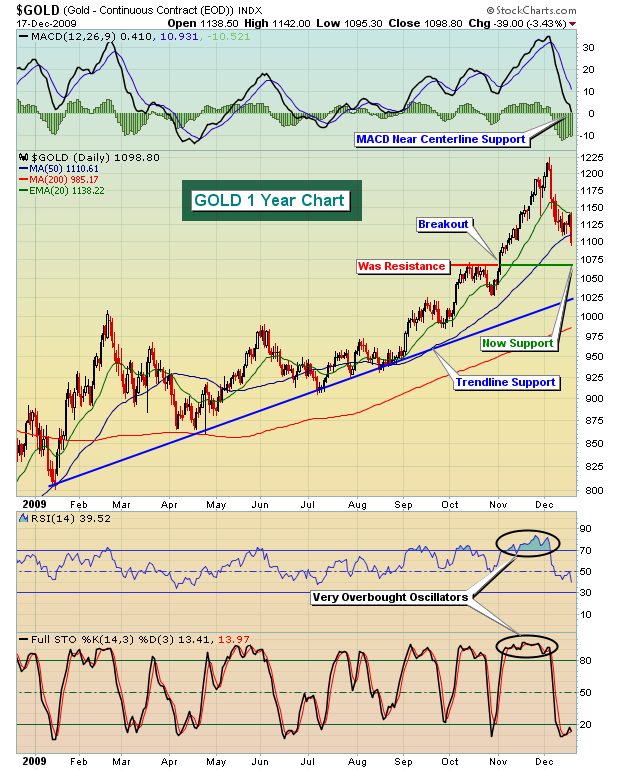
If gold continues falling, I expect it to find near-term support in the $1070-$1080 range, with much more significant long-term support from $1025-$1050. While gold has run into heavy profit taking after a strong surge higher, natural gas prices appear to be breaking out. This is an all-or-nothing commodity where price swings tend to be severe in both directions. I expect natural gas prices to climb to at least $7.00, possibly as high as $9.00-$10.00 during the first few months of 2010. Currently, the trend is higher as reflected below:

Until the uptrend in natural gas prices reverses, I'd be a buyer of those stocks that benefit from the uptrend. There is a very tight correlation between the performance of key natural gas stocks and the price of natural gas itself. I've featured one such stock - Chesapeake Energy (CHK) - as our Chart of the Day for Monday. You can view an annotated version of this chart and see the correlation between the company's stock price and the price of natural gas by checking out our Chart of the Day. CLICK HERE
Happy Holidays! On behalf of Invested Central, I want to wish everyone a safe, happy and healthy New Year!
We'll be the first to admit that we are bearish on the housing market; and we are bullish on 10-year not yields that will ultimately have a negative impact upon mortgage rates and hence home sales. However, our fundamental backdrop really doesn't square well with our technical viewpoint on the Housing Index ($HGX). The question therefore is whether the liquidity driven rally of the past 9-months will reappear in $HGX. The probabilities favor it doing so just ever so slightly in our opinion.
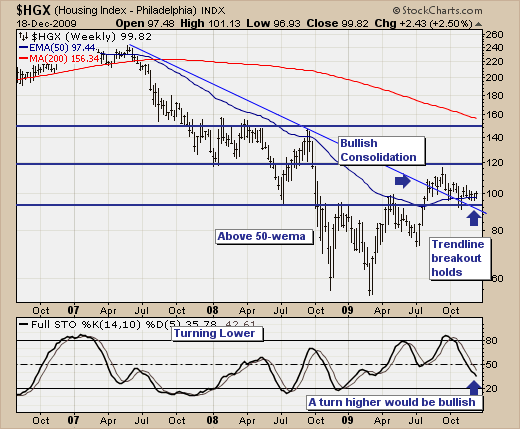
The weekly $HGX chart now shows a series of rising highs and lows of the March-09 bottom, and indeed prices did breakout above near-term resistance in the 80-to-90 range in bullish fashion. Moreover, prices have built upon this by holding above the breakout level, and have further broken out above the 50-wee exponential moving average and trendline resistance. In other words; 3 very important resistance levels have been taken out. Now, prices are consolidating in bullish fashion as the 14-week stochastic is moving lower - which in our experience means that more often not - prices are going higher. Our initial target would be the previous highs at 120; and then higher into overhead resistance at 150-to-155...where the 200-week moving average crosses at the present time.
We find this rather difficult to reconcile commonsensically, and indeed the potential breakout remains just that - a possibility rather than anything hard. But it certainly bears watching, for we will be leverage to be had here if the funds sense a newly minted trend higher given the still large outstanding short position. We're skeptical; but open to the potential of our skepticism being completely wrong.
Good luck and good trading,
Richard